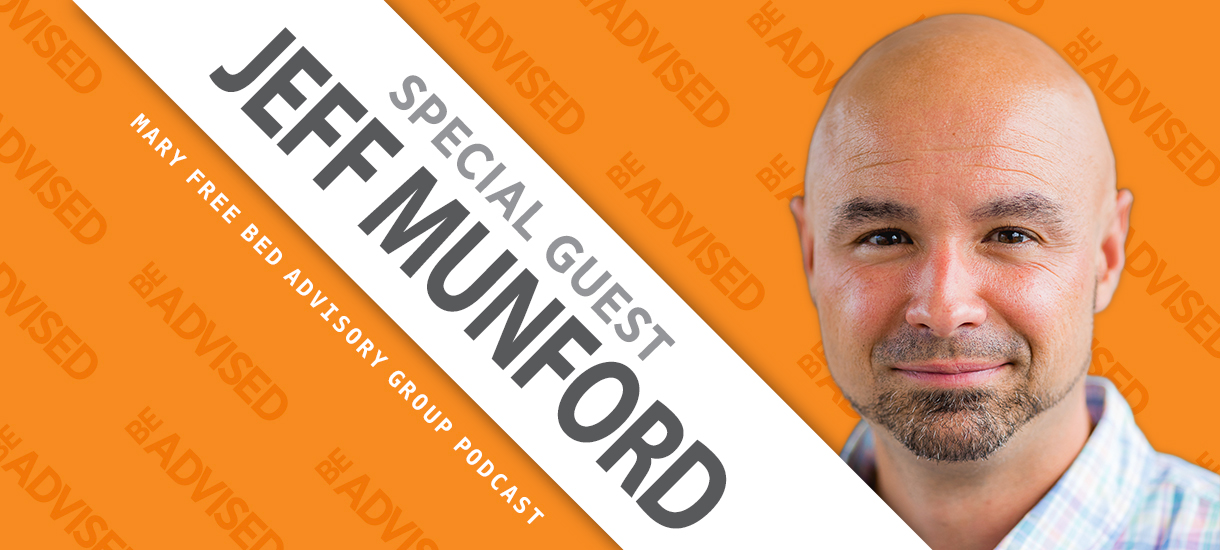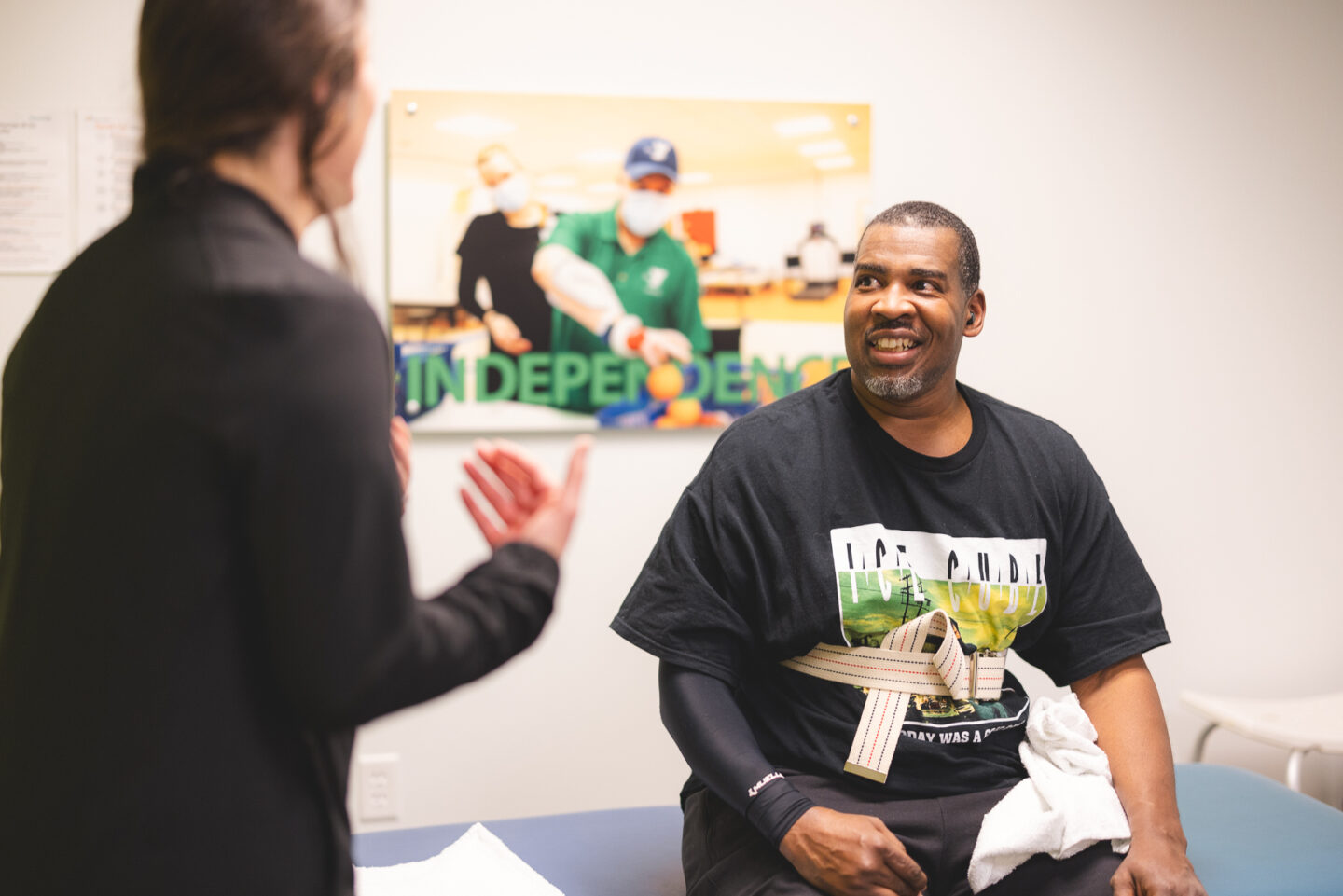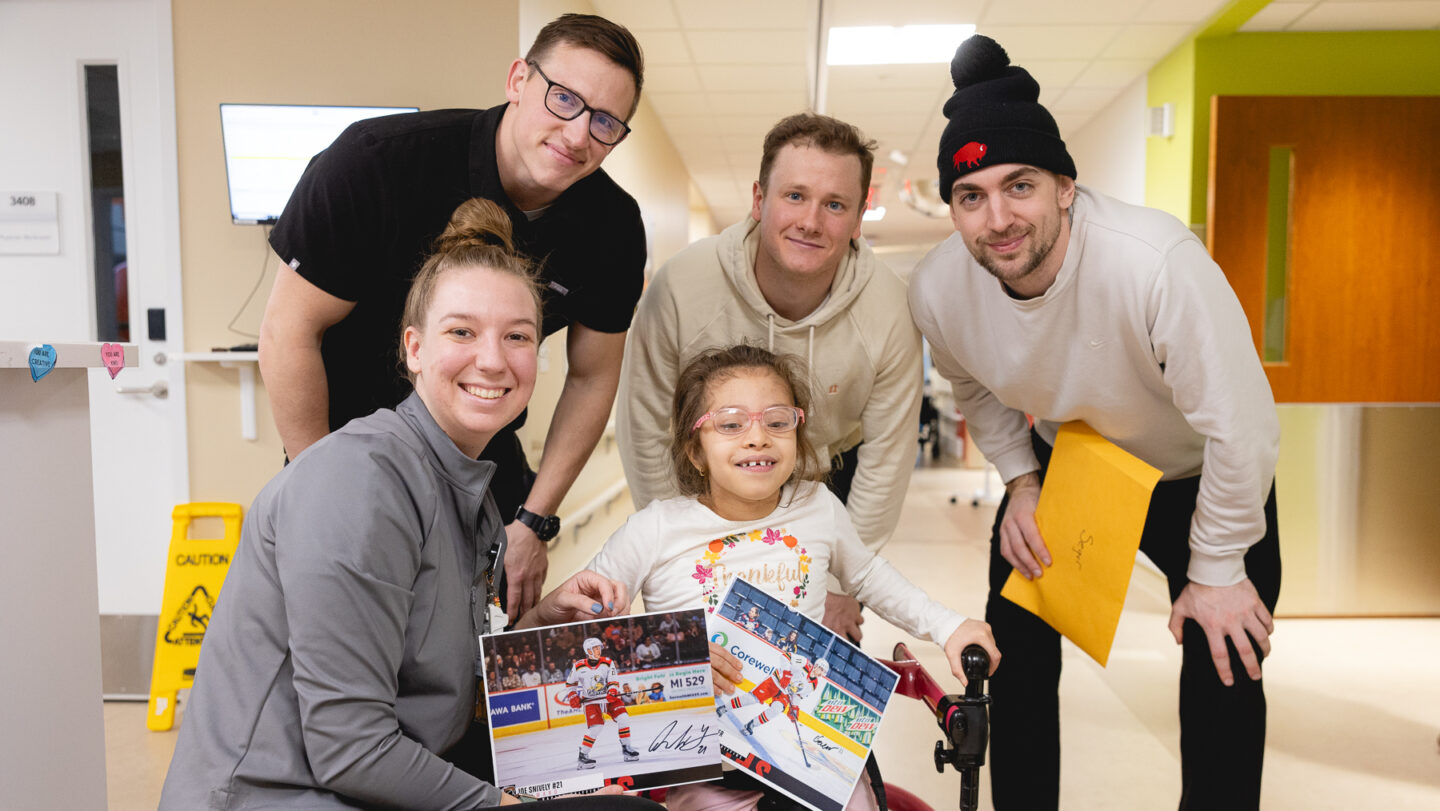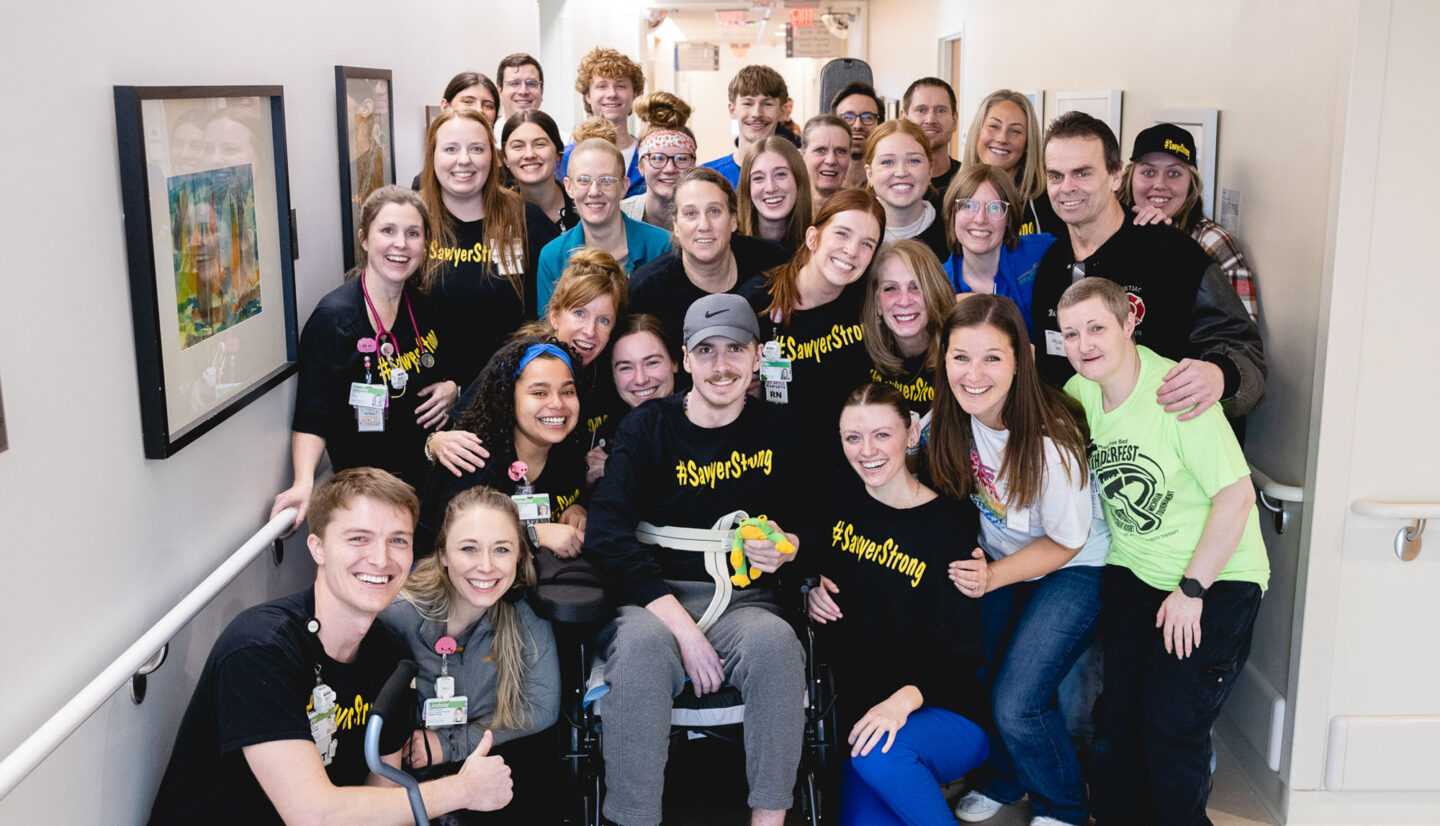Posted on September 13, 2023
Be Advised: Referral Development and Best Practices for Growing Patient Access
Want to grow your business and increase access for patients? The Be Advised podcast is back with a new episode to answer your referral questions.
Mary Free Bed’s Advisory Group podcast, Be Advised, highlights all things referral development with Mary Free Bed’s Jeff Munford. He shares his experience and insight from 15 years working in access and business development at the rehabilitation hospital.
Jeff currently serves as vice president of patient access and referral development for Mary Free Bed. He joined Mary Free Bed in 2008 to lead an expanding business development and marketing team. In that time, he’s led a team through immense growth as Mary Free Bed expanded from an 80-bed inpatient rehabilitation hospital in Grand Rapids, to a system of over 400 beds throughout the Midwest.
Be Advised is hosted by Joyal Pavey, vice president of the Mary Free Bed Advisory Group. On this episode of Be Advised, Joyal and Jeff discuss:
- Data driven decisions
- Best practices
- Outcome sharing
- Response times
Listen to the episode here, or wherever you get your podcasts.
For questions about this or other Be Advised podcasts, email us at: AdvisoryGroup@maryfreebed.com
Find out more about the Mary Free Bed Advisory Group.
Read the full podcast transcript below:
Joyal Pavey:
Here, so before we dive into details, would you mind Jeff sharing a little bit more about yourself with our listeners and tell them about your background and your role at Mary Free Bed?
Jeff Munford:
Sure thing. And I got to say, I appreciate the generous introduction Joyal. My name is Jeff Munford, vice president, patient access and referral development. I’ve been with Mary for a bit for about 14 years now in a variety of different positions. I came to Mary Free Bed from the pharmaceutical industry doing sales and territory management, which I applied in my first role with Mary free Bed. I was hired to do referral development for specific service lines for outpatient and orthotics and prosthetics. And at that time, we were somewhat of a stagnant inpatient rehabilitation hospital and that changed pretty quickly after I was with Mary free bed for only a few years, and we decided to really flip into growth mode because we realized that we were really underserving our community as far as the inpatient side goes. Fast forward 12 years later, I’ve been working with admissions and referral development for about that long. We now have 38 clinical liaisons spread across the entirety of the Midwest that provide patients access to inpatient rehab services throughout the entirety of the Mary Free Bed Network. And that team has really grown from at the very beginning about four clinical liaisons to, like I said, almost 40 now. So, it’s been a really interesting ride and I’ve been very fortunate to be part of it. Back when I first started working with admissions, we were at 80 beds, all semi private in patient rehab hospital. Now we’re 167 beds on the main campus in Grand Rapids and we have a whole rehabilitation network across the entirety of the Midwest, so now the entirety of the access team, inclusive of our consulting physiatrist is well over 50 people. So, things have gotten a lot bigger, a lot more complex, and we’ve integrated really well with all of our acute care partners by really identifying the needs of any given acute care system and really striving to meet those needs.
Joyal Pavey:
That’s amazing, Jeff. What you and the team has have accomplished, at Mary free bed, we always say, we’re serving the patients. Patients need access to care and we know there’s so many barriers today to access safe rehabilitative care. You and your team and the consult physicians have really overcome some of those barriers for us. And what I was hoping that you could talk about, which you’ve went over many, many times with me, as we work with new network partners, and we provide consulting services is really the difference between referral development and referral management. In your mind and for our listeners, can you explain to us the difference between those two things and why they’re each so important?
Jeff Munford:
Yeah, it’s a really good question and It’s really good to divvy those two up. They do go hand in hand, but in any given acute care system in my role, I feel like I wear two hats, so the referral development piece of it, , to me and the team and really inclusive of everyone is more about marketing outreach. Education with our most influential referral partners. And so that is really throwing the net further so that we have the opportunity to screen more patients and serve more patients. Ultimately, the referral management piece of it really is what I think of as operations. So it’s everything from, once you get that referral, you do the patient evaluation all the way into what that looks like when that patient is admitted to any given inpatient rehab facility where we oversee this process.
Joyal Pavey:
So, Jeff, you really have key performance improvement metrics for both referral development and referral management. And what would you say would be the three top key performance indicators that you’re looking at monthly and how is this driving your decision making for each of those two roles you just described?
Jeff Munford:
It’s pretty hard to whittle that down to three. I’d ask for some leeway here, and I’ll give you 4. So really what I’m looking at, on the front-end part of it, when we’re looking at our marketing activity and what we’re doing on the outreach side. It really is referrals and then we dig into the referrals where they coming from, why they refer. We are very data-driven and we capture an incredible amount of data up front so that we can make very informed decisions. the second key performance indicator really is what ultimately happens. It’s did that referral result in an admission, did we serve that patient? If so, how did we do on that intake process? What’s that referral management process? Another piece is what makes us valuable, , to as far as the throughput process goes, in the acute care side and that’s onset days, some of the so onset days being the measurement from date of injury to the time where you would admit that patient to a rehab Facility. That’s a really important one so that we can see. How we can more efficiently pull that through in the referral management piece? The other piece of this that especially in the last handful of years, it’s gotten so important is to. How do we manage our denials? Whether it’s denials from an insurance provider or if a patient decides to go somewhere else? If a patient is determined to be too low functioning to meet her admission criteria, what do we do with that denial? Data leads to a lot of opportunity, really, , so we can pull our payers. Closer with data in outcomes measurements and we can also take some of those buckets and determine whether or not we want to do program development with. And I have seen some of this information have a direct correlation to serving more patients, so like I said that’s four and I’ll leave it there. There are others, but those are the big ones.
Joyal Pavey:
Yeah, those are really big topics and like you said, there’s so many decision points and one of the points I kind of want to drive home is something that I know our team at Mary free Bed does very well is timeliness of response to referrals in a highly competitive environment can you talk about what? Some of our expectations are around responding to those referral timely.
Jeff Munford:
Yeah, this is a metric that’s evolved overtime. as we’ve seen the return on investment of having a broad network of clinical liaisons, the expectations for turnaround time on a response to her referral has changed. So now referrals come in all different ways. Sometimes, a consult for what the physiatrist looks like a referral. Sometimes you get a referral from an acute care facility that’s 300 miles away, and that’s going to come through electronic. But in general, we like to see a response and an acknowledgement of that referral within 30 minutes? And so, we can track that through most ways that they come in, but not all, I would say that that’s the general expectation. And then as far as, the clinical piece of it goes if we’re integrated with boots on the ground with the clinical liaison, alongside of a consult, Physiatrist. We like to see consults started within the same day if the Council’s called in at 6:00 PM, the expectation is not going to be that we’re going to complete that Council then. But first thing in.
Joyal Pavey:
The morning Jeff and I think that’s important for our listeners to distinguish because there’s programs out there that don’t have a consult service. And So, what you’re saying is you’re really using our consult. Physician service as an extension of your liaison team to clinically assess the patient’s appropriateness. And we know that providers that assess the patient’s earlier help. Set the patient. Up for future success and mapping the course of their post. Your journey. And So, what you’re saying is physicians that you’re consulting, if you’re going to run a consult service, they have to respond timely to that consult and you can’t be sitting there delaying admissions, waiting for physician consults.
Jeff Munford:
That’s exactly right, a consult service, best practice model that we’ve set up really is to have a physiatrist working alongside of, , 1-2 clinical liaisons so that they can be that much more efficient as a team and also as a physiatrist. So as soon as the sooner that we can get the ball rolling. And integrating with the team, the treatment team that is in the acute care setting, the better. So really our our clinical liaisons and physiatrists that work at any given referral source, acute care hospital that is. Usually look more like an employee of that hospital than they do Mary free bed. Or at least it’s a blending of the both because they work with therapy, care management, the hospitalist team, any given navigator to make sure that these patients are getting to the right post acute care setting is efficiently as possible.
Joyal Pavey:
Yeah, I think that’s so important because you’re really talking about relationship building, right? So we’re not just coming in and being viewed as a separate entity. We’re really melding with our referral sources, team members. We’re helping them do their jobs easier, more efficiently and effectively by just being an extension. Of their team, we’re kind of all becoming the same team and working closely together and that happens to the skills that you and our liaisons and our business development team have is just building those relationships with our partners. Yeah, exactly. And, like I said, this has been an evolution 10-12 years ago when we started going down this journey of growth and, being a better partner to the acute care systems, the two metrics that for the first year of this job that I had that I really measured were referrals and emissions. Now it really is long term.
Jeff Munford:
Within any given hospital system, what is their post acute care utilization? Look like does it look like it’s up to industry standard? What is their acute care length of stay look like versus what the region and the nation would say that it should. Those types of data points to really talk about transparently with our acute care partners are mutually beneficial. So, it really goes back to relationships. Integration and how can we best serve the community?
Joyal Pavey:
So, Jeff, we’re talking about metrics and relationships. And one thing that I know that you use is both a metric and a tactic used to help. Build relationships and trust with providers and that’s using patient outcomes. So, can you explain to our listeners how our team are using patient outcomes for referral development?
Jeff Munford:
So we have a variety of ways that we report back patient outcomes. , so our marketing team reports through patient outcomes through our social media outlets, but really, on the referral development management side, what we’re doing is we’re reporting patient outcomes by program, , overall and then really what we like to do is develop these hospital specifics. More cards so that we can report back to any given acute care system how the patients that we admitted from them did what programs they returned to in that Community, whether it’s a, it’s a program that, that acute care system is affiliated with or not. We serve 300 patients from your facility in the last in the last year. These are how they did, , these are how they admitted in in these are is what they look like functionally when they discharged and where they discharged to. So, I really like that we have the capabilities to be able to do that throughout our system. I don’t think that everybody does, but I’m very grateful that we do so we take full advantage and it is really appreciated. Especially by, just throw out an example like, A trauma team. So a trauma team is really the team that saves someone’s life, to just put it simply and then that patient goes off to an inpatient rehab facility or wherever they go to. And it is really nice to be able to tell those stories back. Hey, you saved Mrs. Smith’s life. This is how she admitted. And this is how she discharged. what an amazing journey she had. I just wanted you to know that she is back to doing what she loves.
Joyal Pavey:
That’s great. That’s great. And I know some of our even marketing and our patient stories show the entire patient journey. It’s about that partnership with your acute care provider. So, we’re showcasing that trauma surgeon or that specialty physician that treated the patient in acute as well as the inpatient rehab team and positions at Mary Free Bed and we’re mapping out that that journey the patient had and again we’re building that relationship with our referral sources. I think that’s so valuable.
Jeff Munford:
Yeah, it’s been great, to be able to do that especially. Really, in any given community, , if you have, , a few major referral sources in your, , the the major inpatient rehab facility in town. You’re going to get to know who those players are. really. The next level is developing a relationship with the treatment team. Stick with trauma because in general, trauma patients will travel for very specialized programming, spinal cord injury, brain injury. We’ve been able to really build relationships with hospitals that are two 300 miles away that have really come to rely on the specialized services of Mary Free Bed and really trust that, they’re it is worth it for that patient to travel all the way across the state or across state lines at times and their family. Is going to have to make that track once or twice throughout the rehab journey too, that it’s worth it and it’s valuable for them to. Come and that is because of the trust and the relationships that have been developed really through our treatment teams and we try to facilitate that as much as possible.
Joyal Pavey:
Absolutely. So, Jeff, your team talks about care transitions a lot and being able to see mostly transfer patients from one level care to the next. Can you describe your, your decision points and your process to make these care transitions seamless for patients?
Jeff Munford:
Sure. Yeah, that’s a big part of the whole referral management development piece that we’re response. Useful for so. Healthcare is getting more complex, not less complex. all the time. So any given post-acute care provider is treating a more complex patient. All the data says so and it’s been creeping that way for years. So, with a with a focus on that one of the main one of the big ways, the major initiatives that we have. Through patient access, we identify patient types. I’ve said before that we’re very data-driven in our decision making. So, we would do an analysis, along with our acute care partner of patients that need to that aren’t getting to the level of care that they need to get to most efficiently and then together. We build out work groups, so I’m just going to take a group of neuro patients, for example, in a hospital that has 30,000 total discharges a year. That’s a lot of patients. So, what you would do with those patient types is you would get the appropriate teams together. And build out some processes so that you’re most efficiently guiding acute care therapy so that these patient types are identified appropriately where their care journey is going to take them eventually. And that way you increase all the communication you build in these systems because there’s always new players. And we’ve seen tremendous turnover on various teams in the acute care setting. And so, building out processes is really the way to make sure that we’re very efficient with our referral management. And that really speaks to patients that come to inpatient rehab or that we do a nice handoff to another level of care is most appropriate.
Joyal Pavey:
Absolutely. That’s so important, Jeff. And I think we don’t have enough time today to talk about the full scope of the program and all the things that your team does to make sure that patients have access to medically necessary rehab services and that’s exactly what your team is out there doing. I’d love to hand you back if you would like to be our guest. Again, I can’t thank you enough for joining us today. Before we leave our audience, do you have any final words of wisdom to share with them today?
Jeff Munford:
I think any words of wisdom I have just come from both personal and professional experience I have seen what a lack of communication as far as the healthcare system as a whole has led to with some of my family members. And then I also see professionally that there is really opportunity everywhere. So, you put the patient at the middle of all your decision making and really. That should guide all of our decisions, so patient access to me is something I’m very passionate about and I would love to come back, and I can talk forever on the subject.
Joyal Pavey:
Jeff, we would love to have you back. You’ve created a great infrastructure at Mary free bed and develop processes that have proven to really be effective for our patients. I can’t thank you enough for sharing your expertise with us today. Thank you everyone for joining us today.






